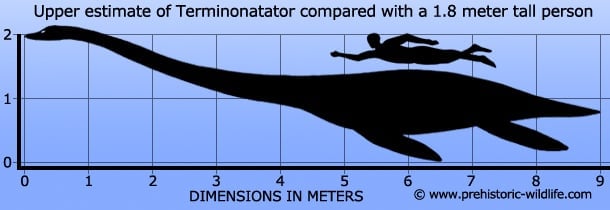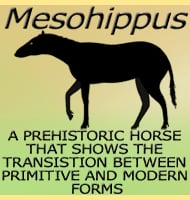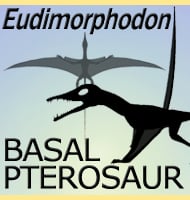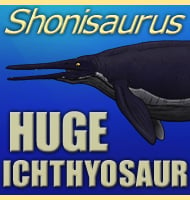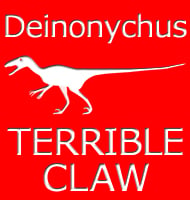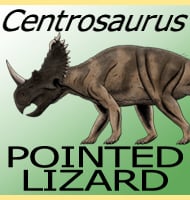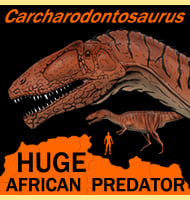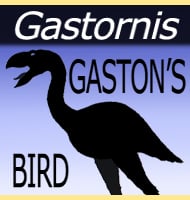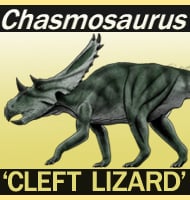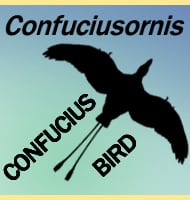In Depth
With remains that were found in Campanian age rocks Terminonatator was possibly one of the last elasmosaurid plesiosaurs to swim in the ocean. This is a far cry away from the Jurassic heyday of the plesiosaurs when they were one of the most common types of marine reptile in the ocean. In the Jurassic plesiosaurs had to contend with being hunted by large pliosaurs such as Pliosaurus and Kronosaurus, but the Late Cretaceous waters of the Western Interior Sea Way which submerged large portions of central North America were probably even more dangerous. Here Terminonatator would have had to contend with mosasaurs like Tylosaurus which was possibly larger and faster than the previous pliosaurs, as well as large sharks such as Cretoxyrhina which seem to have eaten anything in front of them, including marine reptiles.
Evidence for how dangerous these waters were comes from the right thigh bone of Terminonatator which was broken but managed to heal. It is uncertain how this injury occurred but could quite possibly have been caused by an impact with another marine reptile. On a related note the femur (upper leg bone) of the rear flippers is longer than the equivalent humerus (upper arm bone) of the front flippers, which is different to the usual elasmosaurid configuration. It remains uncertain what effect a more developed set of rear limbs would have had on swimming, but it may have allowed for a more powerful stroke which could have granted Terminonatator a boost in speed and possibly manoeuvrability, both making it easier for Terminonatator to evade predators.
The skull of Terminonatator displays most of the typical elasmosaurid features of prey capture; typically long conical teeth that intermeshed together when the jaws were closed. Seventeen to eighteen teeth were in the each side of the dentary (lower jaw), while at least thirteen teeth were in each side of the maxilla (main upper jaw). The premaxilla (front of the upper jaw) had nine teeth, but without further specimens it is impossible to say if this is typical of the genus or just the individual. Together this means that Terminonatator had around sixty-nine to seventy-one teeth in its mouth, although the actual figure may still have been a little higher.
The overall appearance of the skull and lower jaw for Terminonatator is quite unique compared to other elasmosaurids. The snout was quite short compared to other elasmosaurid plesiosaurs and the pineal foramen, a hole in the skull where a light sensitive organ is sometimes found in reptiles is completely closed. This suggests that Terminonatator did not rely upon sensing the direction of the light above which raises the question of was it nocturnal? Without the scleral rings of the eyes it would be impossible to say if were nocturnal or not, but by being so Terminonatator might have been able to avoid the larger predators of the day, possibly explaining why it was still managing to stay alive when the plesiosaurs and particularly elasmosaurids had greatly declined in numbers.
The lower jaw of Terminonatator also has an extended coronoid process, a bone that rises from the lower jaw into the skull and serves as an area for muscle attachment. A more developed bone suggests a more developed muscle system that may not necessarily mean a stronger bite but a faster one. A shorter snout would also reduce resistance when opening in the water which could have increased jaw opening times. Fast jaw opening and closing could mean a specialisation in hunting faster moving fish, with a speed boost from slightly more developed rear limbs helping in the pursuit of prey. Unfortunately the rear portions of the skull of the holotype are damaged and incomplete and as such it is difficult to infer the full workings of the skull with accuracy.
Despite the incompleteness of the skull however, partial impression of the brain have been found, giving palaeontologists a rare glimpse at elasmosaurid biology. One area that stands out seems to be a well-developed olfactory area. This connects to a wider theory about how marine reptiles could sniff the water to pick up smells that were drifting in the currents and how some marine reptiles are thought to have had directional smell that helped them to locate things like prey. The actual size of Terminonatator is still something that is not known as an absolute as there are two main factors to consider. The type specimen of Terminonatator has vertebrae that are fused to the neural arches, something which is taken to suggest that it had reached adulthood. However other parts of the skeleton that should be fused are not which suggests that this specimen of Terminonatator may in fact be a sub adult that had reached almost adult size, but still had bit to go yet. The second thing to consider is the true length of the neck. If Terminonatator had an exceptionally long neck similar to that seen in some like Mauisaurus then it may have been even longer with a total length of nine rather than the seven meters usually attributed to it. However it’s worth remembering that this extra length would just be extra neck and that Terminonatator would still be towards the smaller end of the elasmosaurid size scale.
Plesiosaurs are thought to have swallowed gastroliths, and clear evidence for this can be seen in the Terminonatator holotype which has over one-hundred and fifty pebbles (some six centimetres across) which were found inside the stomach area of the body. While these pebbles would have weighted Terminonatator down in the water so that it was neutrally buoyant, another main reason for these stones would have been to aid digestion. You must realise that while the sharp teeth of Terminonatator were excellent for catching prey like fish, they could not cut through flesh and so fish would have likely been swallowed whole. The grinding action of the stones in the stomach would have helped with the digestion of this fish, and further support for this comes from ground up fish bones amongst the gastroliths in the belly of a specimen of an elasmosaurid called Styxosaurus.
The type species name of T. ponteixensis means ‘from Ponteix’, the town near where the remains were recovered.
Further Reading
– Terminonatator ponteixensis, a new elasmosaur (Reptilia: Sauropterygia) from the Upper Cretaceous of Saskatchewan. – Journal of Vertebrate Paleontology 23(1):89-103. – Tamaki Sato – 2003.
